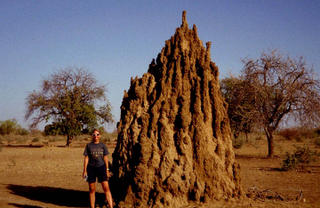Communication among termites is not completely understood. Since they live and work in darkness, they are blind, as we know the term. Smell and touch seem to be the preferred form of communication. Termites build nests from a material that they make with body chemicals and cellulose, wood fiber. Big termite nests, like those found in Africa or Australia, can be several feet high and last decades. A nest may contain millions of individuals. Termites require carefully controlled humidity and temperature conditions inside the nest. The structure and material provide this function. Function and form are in consonance.
Construction of a nest follows a simple procedure. At some point for reasons unknown, and by mechanisms unknown, upon sensing a "signal" of some sort, termite workers start producing the pellets of material they use to construct nests. The termites begin to pile these pellets, each working individually, cementing them together with an adhesive they produce.
At some later time, sensing another "signal," the workers "look" around them. If they see a pile of pellets larger than theirs in the immediate vicinity, they abandon their project and go work on the higher pile. Through this process they select those piles they will work on.
A little while later, sensing still another "signal," the workers "look" around to see if there is a pile of nearly the same height within a specified distance of the pile they are working upon. If not, they abandon their pile and search for two piles that are close together. Again, after time has elapsed, termite workers begin to form the arch at the top. This process is repeated many times until an interlocking web of randomly constructed arches is completed.
In this process there are no high-performing termites. The entire process can be written in the form of a set of simple logical instructions - a program. There is no plan. Randomness plays an important role. The instructions and the responses seem to be genetically programmed into the termite worker. Signals do not seem to be given by anyone. Environmental conditions dictate the start of the process. When it is time to build a nest, a nest is built. The processes can be defined logically, analytically. Time may even play a role in the behavior changes once the building has begun. No one has a vision of the outcome. Everyone follows the rules and the result is functionally correct, but not elegant.
 I wonder what a city landscape would look like if it was populated with buildings that all looked like this. To me, it would look like an artist version of an alien planet.
I wonder what a city landscape would look like if it was populated with buildings that all looked like this. To me, it would look like an artist version of an alien planet.The question that haunts me in this age of peer to peer collaborations, with dependence upon emergent behavior from a large group of individuals, is the results may be functional, but will they be beautiful? Or, is beauty as a concept simply going to disappear? Or will we see functionality as beauty?
Morrison was interested in another question, "Could the termites eventually build a telescope?"
Even though termites can construct arches, could they ever build a cathedral?
More to the point, could we, if we operated in like manner?
What are the limits of free, open collaborative systems? It's hard to image any of modern civilizations greatest projects being completed in this manner.

No comments:
Post a Comment